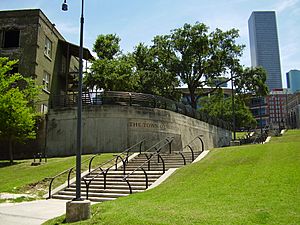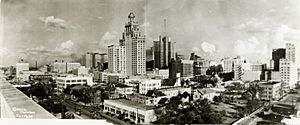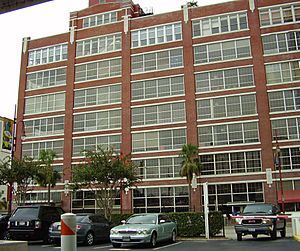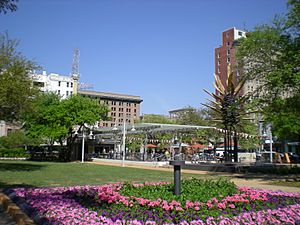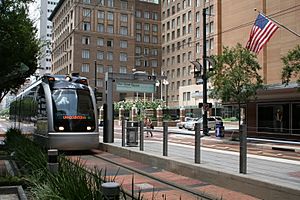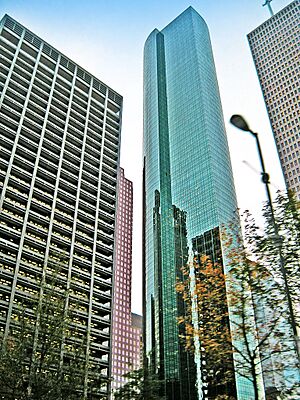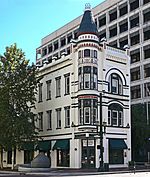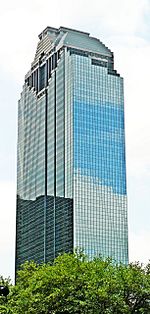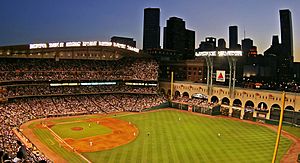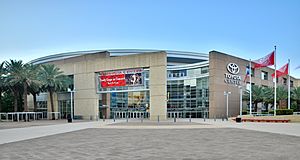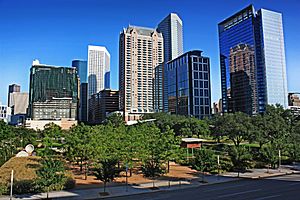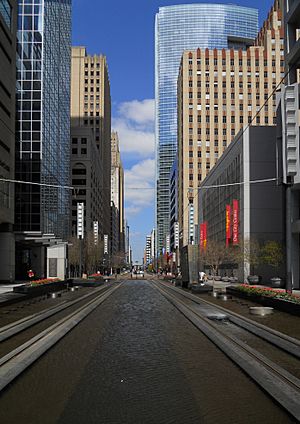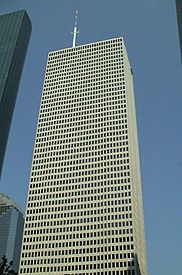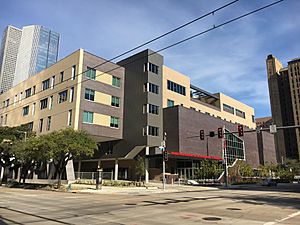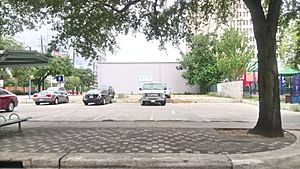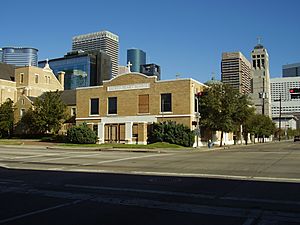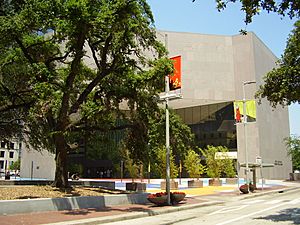Downtown Houston facts for kids
Quick facts for kids
Downtown Houston
|
|
|---|---|

The Downtown skyline from the west.
|
|
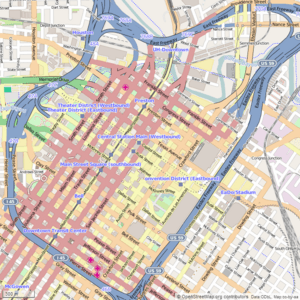
Road map of Downtown Houston.
|
|
| Country | |
| State | |
| County | Harris County |
| City | |
| Settled | 1836 |
| Subdistricts | |
| Area | |
| • Total | 4.8 km2 (1.84 sq mi) |
| Population
(2017)
|
|
| • Total | 10,165 |
| • Density | 2,133/km2 (5,524/sq mi) |
| Greater Downtown (within 2 miles): 74,791 | |
| ZIP Code |
77002
|
| Area code(s) | 281, 346, 713, and 832 |
Downtown Houston is the main business area in the city of Houston and the largest in the state of Texas. It's located near the center of the city, where major highways like Interstate 10, Interstate 45, and Interstate 69 meet. This area, about 1.84 square miles (4.77 km²) big, is where Houston first started in 1836, near the Buffalo Bayou and White Oak Bayou rivers, at a spot called Allen's Landing. Downtown has been the city's most important business district since it was founded.
Today, Downtown Houston is home to many big companies, including nine Fortune 500 corporations. It has a huge amount of office space where about 150,000 people work. Downtown is also a super fun place for entertainment and activities. The Theater District has many places for shows, like the Alley Theatre, Hobby Center for the Performing Arts, Jones Hall, and the Wortham Theater Center. You can also watch professional sports at Minute Maid Park, home of the Houston Astros baseball team, and the Toyota Center, where the Houston Rockets basketball team plays. Discovery Green is a cool urban park right next to the George R. Brown Convention Center, which is a huge building for big events.
Downtown is also where Houston's city government is located, with Houston City Hall and the courthouses for Harris County. It's a main spot for public transportation, with the light rail system and bus routes all meeting here. Over 100,000 people travel through Downtown every day. There's even an amazing underground tunnel system with shops and restaurants that connects many buildings, so you can walk around without going outside!
Downtown Houston is surrounded by other neighborhoods like East Downtown to the east, Third Ward to the south, and Midtown to the southwest. The streets in Downtown are laid out in a neat grid pattern. The Buffalo Bayou river runs through the northern part of the district, and its banks have cool trails for walking and biking.
Contents
History of Downtown Houston
Downtown Houston is where the city first began. After the Texas Revolution, two brothers from New York, John Kirby Allen and Augustus Chapman Allen, bought a large piece of land in 1836. They first arrived at the spot where the White Oak Bayou and Buffalo Bayou rivers meet, which is now called Allen's Landing. A city planner named Gail Borden, Jr. helped design wide streets for the new town.
Houston officially became a city on June 5, 1837, and for a while, it was the temporary capital of Texas. In 1840, the town was divided into four main areas called "wards," each with different purposes. By 1906, what is now Downtown was part of six wards. Even though these wards are no longer political divisions, their names are still used to describe different parts of the city.
Downtown Houston grew a lot because of two big reasons. First, after the terrible 1900 Galveston hurricane in 1900, many investors looked for a safer place near the ports of Southwest Texas that wasn't hit by hurricanes as often. Houston became a good choice because only the strongest storms could reach it. Second, a year later in 1901, oil was discovered nearby at Spindletop. Shipping and oil companies quickly moved to East Texas, and many settled in Houston. From then on, Downtown grew a lot, and many tall skyscrapers were built, including some of the city's tallest.
In the 19th century, the east side of Downtown Houston was a fancy neighborhood with beautiful Victorian homes. But around 1910, when Union Station (a train station) was built, the area changed. Hotels opened for travelers, and over time, some of these hotels became less fancy. When Interstate 45 was built in the 1950s, it separated parts of the historic Third Ward and brought them into Downtown.
In the 1960s, as the 610 Loop highway was built around Houston, the city's focus started to move away from Downtown. Downtown became less of the only important center and more like one of many important spots in the city. In the mid-1980s, an economic downturn caused some businesses in Downtown to struggle, which also affected the area.
A very special event happened on April 5, 1986, when French musician Jean-Michel Jarre held a huge outdoor concert called Rendez-Vous Houston. The concert used the skyscrapers as giant screens for projections and fireworks. It celebrated 25 years of NASA and 150 years of Texas, and it was a tribute to the astronauts who died in the Space Shuttle Challenger disaster. This amazing show brought in a record 1.3 million people!
Over time, more highways were built in the 1960s and 1970s, which set the current boundaries of Downtown. Downtown used to be the main shopping area in Houston. But in the 1970s and 1980s, new shopping centers were built in the suburbs, making Downtown less important for retail. More recently, a program called the Downtown Living Initiative has encouraged developers to build new homes and mixed-use buildings in Downtown to attract more people to live there.
The building boom of the 1970s and 1980s saw many tall buildings go up, with some becoming the tallest in Texas and even the country.
What Makes Up Downtown Houston?
Downtown Houston covers about 1178 acres (4.77 km²) and is surrounded by Interstate 45, Interstate 69/U.S. Highway 59, and Interstate 10/U.S. Highway 90. It's divided into several cool districts:
- Warehouse District – This area is known for its unique art scene, cool restaurants, live music, and some of Downtown's first loft apartments.
- Historic District – This is the original heart of Houston, dating back to the 1800s. The main spot here is Market Square Park, where the first city hall used to be.
- Harris County District – This district includes the courthouses for Harris County, and the University of Houston–Downtown is right on its edge.
- Ballpark District – Home to Minute Maid Park, where the Houston Astros play, along with restaurants, lofts, and offices nearby.
- Convention District – This area features the George R. Brown Convention Center, Discovery Green park, the Toyota Center (for sports and concerts), and some of the city's biggest hotels.
- Skyline District – This is where many of Houston's tallest skyscrapers are, forming the main business area. These buildings are connected by the amazing underground tunnel network.
- Shopping District – Here you'll find Main Street Square with its fountains, plus shopping centers like GreenStreet and the Shops at Houston Center.
- Theater District – This 17-block area is packed with performing arts venues, Bayou Place, and the Houston Aquarium restaurant.
- Civic Center District – This is the core of Houston's government, including City Hall. The Houston Public Library Central Library is also here.
- Medical District – This area includes St. Joseph Medical Center, homes, and the Sacred Heart Co-Cathedral.
Many of the homes in Downtown are older buildings that have been turned into modern loft apartments. These lofts are often found near the Houston Theater District and Main Street in the Historic District. In 2009, a luxury high-rise called One Park Place opened with many new apartments.
Developers have invested over $4 billion in the last decade to make Downtown a lively city center with homes, nightlife, and new transportation. On January 1, 2004, the "new" Main Street opened, which is a plaza with lots of restaurants, bars, and nightclubs, bringing many visitors to the area.
Tall Buildings and Architecture
In the 1960s, Downtown Houston had a modest number of mid-rise office buildings. But since then, it has grown into one of the biggest skylines in the United States! In 1960, the main business area had 10 million square feet (930,000 m²) of office space, which grew to about 16 million square feet (1,500,000 m²) by 1970. Downtown Houston was ready for a huge building boom in 1970, with many new office spaces planned or being built.
The first major skyscraper built in Houston was the 50-floor, 714 ft (218 m) tall One Shell Plaza in 1971. Many more skyscrapers were built throughout the 1970s. The tallest one was the 75-floor, 1,002 ft (305 m) tall JPMorgan Chase Tower (which used to be called the Texas Commerce Tower), finished in 1982. In 2002, it was the tallest building in Texas and one of the tallest in the United States. In 1983, the 71-floor, 970 ft (296 m) tall Wells Fargo Plaza was completed, becoming the second-tallest building in Houston. Skyscraper construction in Downtown Houston slowed down in the mid-1980s due to economic changes.
Famous Buildings in Downtown
Here are some of the notable buildings that make up Houston's Downtown skyline:
- The Sweeney, Coombs, and Fredericks Building is an old commercial building from 1889 with a cool corner tower. It's one of the few Victorian-style buildings left in the city.
- The Gulf Building, now called the JPMorgan Chase building, is a beautiful Art Deco skyscraper from 1929. It was the tallest building in Houston until 1963.
- The Esperson Buildings, 'Neils' (1927) and 'Mellie' (1942), were designed with Italian architecture.
- The Houston City Hall was built between 1938 and 1939 and is a great example of the Art Deco style.
- One Shell Plaza was the tallest building in Houston when it was finished in 1971, standing 715 ft (218 m) tall.
- The Houston Public Library Central Library has two buildings: the historic Julia Ideson Building (1926) and the modern Jesse H. Jones Building (1976).
- Pennzoil Place, built in 1976, is famous for its unique and award-winning design by Philip Johnson.
- The JPMorgan Chase Tower, designed by I. M. Pei, was built in 1981. It's the tallest building in Houston and the second tallest in the United States west of the Mississippi River.
- The Wells Fargo Bank Plaza, built in 1983, is the second tallest building in the Houston Area.
- The Heritage Plaza was completed in 1987.
- The Hobby Center for the Performing Arts was finished in 2002 and is a major venue for shows.
Consulates in Downtown
Some countries have their consulates (offices that help their citizens and promote their country) in Downtown Houston. For example, the Consulate-General of the United Kingdom is in Wells Fargo Plaza, and the Consulate-General of Japan is in Two Houston Center.
Fun Things to Do in Downtown
Downtown Houston has three major sports venues! Minute Maid Park (opened in 2000) is where the MLB Astros baseball team plays. The Toyota Center (opened in 2003) is home to the NBA Rockets basketball team. BBVA Compass Stadium, which opened in 2012, is where the MLS Dynamo soccer team plays.
The Downtown Houston Theater District is one of the biggest in the country! Houston is one of only five cities in the United States that has professional companies for opera, ballet, music, and theater. Places in the Theater District include the Wortham Center (for opera and ballet), the Alley Theatre (for plays), the Hobby Center (for musicals and concerts), and Jones Hall (for symphony music).
The George R. Brown Convention Center is a huge building often used for big conventions, trade shows, and community meetings. It has lots of space and nearby hotels.
Hotels in Downtown
Downtown Houston has many hotels for visitors, from large well-known chains to smaller, unique "boutique" hotels. Some of the major hotels include the Hilton Americas Convention Center Hotel, Marriott Marquis Houston, and Four Seasons Hotel. Boutique hotels include The Lancaster and Magnolia Hotel.
Shopping in Downtown
You can find shops at the Shops in Houston Center, which is an indoor mall. A few blocks away, GreenStreet is an outdoor shopping area. The Houston Downtown Tunnel System also has many shops and restaurants, especially popular during working hours.
Getting Around Downtown
The Metropolitan Transit Authority of Harris County (METRO) runs Houston's public transportation. Downtown is the center of Houston's light rail system, where all three lines meet. There are several light rail stations in Downtown, like Downtown Transit Center and Main Street Square.
METRO also runs many bus lines through Downtown. There's even a free shuttle called Greenlink that goes in a circle around the district, making it easy to get around. You can also find taxis, and ride-sharing services like Uber operate in the city.
Parks and Fun Spots
Downtown Houston has several great parks and outdoor spaces:
- Sam Houston Park is on the western edge of Downtown and has historic buildings and homes from around Houston.
- Tranquility Park has green spaces and fountains that honor NASA's moon landing.
- Market Square Park is where Houston's old open-air market used to be. It has dog runs and a 9/11 memorial.
- Hermann Park is home to the Houston Zoo, Miller Outdoor Theatre, and the Houston Museum of Natural Science.
- Allen's Landing marks the spot where the Allen Brothers, Houston's founders, first landed.
- Sesquicentennial Park, across the bayou from Allen's Landing, has a statue of former President George H. W. Bush.
- Main Street Square is a pedestrian area with a reflection pool and fountains.
- Discovery Green is a popular park next to the George R. Brown Convention Center. It has underground parking, an amphitheater, restaurants, a dog run, and an interactive fountain.
The Downtown YMCA is located at 1600 Louisiana Street. It has a wellness center, group exercise rooms, and a community meeting space.
Economy of Downtown
Downtown is Houston's biggest office market, with 50 million square feet (4.6 million m²) of space. It has some of the highest office rental rates in the city and was one of the most expensive office markets in the United States in 2016. Louisiana Street, which runs through Downtown, is one of the most expensive streets in the country!
About 3,500 businesses in Downtown employ around 150,000 workers. Big companies like Chevron, JPMorgan Chase, and United Airlines are major employers here. Downtown Houston has a large share of the top-quality office spaces in the city.
Companies Based in Downtown
Many important companies have their main offices in Downtown Houston, including:
- Calpine
- Dynegy
- KBR
- Baker Botts
- Total Petrochemicals USA
- CenterPoint Energy
- Vinson & Elkins
- Waste Management
- El Paso Corp.
- Plains All American Pipeline
- Enterprise GP Holdings
- EOG Resources
Companies with Offices in Downtown
Continental Airlines (now United Airlines) used to have its headquarters in Continental Center I in Downtown. In 1997, Continental announced it would move all its Houston headquarters operations to this complex, which was a big deal for Downtown Houston. Even though the headquarters later moved out, United Airlines still has employees in the building.
JPMorgan Chase Bank has its Houston operations based in the JPMorgan Chase Building. LyondellBasell has offices in the LyondellBasell Towers. Hess Corporation has operations in One Allen Center. ExxonMobil also has offices here. Other companies like Qatar Airways, Enbridge, KPMG, and Mayer Brown have offices in Downtown Houston.
Education in Downtown
Colleges and Universities
The University of Houston–Downtown (UHD) is a four-year state university located at the northern end of Downtown. It was founded in 1974 and is one of the largest public universities in Texas.
The South Texas College of Law is a private law school also located in Downtown. Downtown is also close to the Central Campus of the Houston Community College System.
Public Schools
Children in Downtown Houston attend schools run by the Houston Independent School District (HISD).
There is a public K-8 (kindergarten to 8th grade) charter school in Downtown called Young Scholars Academy for Excellence (Y.S.A.F.E.). The High School for the Performing and Visual Arts (HSPVA), a public magnet high school for students interested in arts, opened a new campus in Downtown in 2019.
Most elementary school students in Downtown go to Bruce Elementary School, Crockett Elementary School, or Gregory-Lincoln Education Center. For middle school, most students go to Gregory-Lincoln Education Center. High school students usually attend Northside High School or Heights High School.
Private Schools
The Roman Catholic Archdiocese of Galveston-Houston oversees the Incarnate Word Academy, which is a Catholic all-girls high school founded in 1873. Trinity Lutheran School, a PreK-8 Lutheran School, is also located near Downtown.
Public Libraries
The Houston Public Library has its Central Library in Downtown Houston. It has two buildings: the Jesse H. Jones Building, which holds most of the library's collections, and the historic Julia Ideson Building, which stores old archives and historical documents.
Houston's first public library opened in 1904. The Ideson building opened in 1926, and the Jesse H. Jones Building opened in 1976. The Jones Building was renovated and reopened in 2008. The Houston Public Library also has a smaller branch called HPL Express Discovery Green, which opened in 2008 near Discovery Green Park.
Images for kids
See also
 In Spanish: Downtown Houston para niños
In Spanish: Downtown Houston para niños


